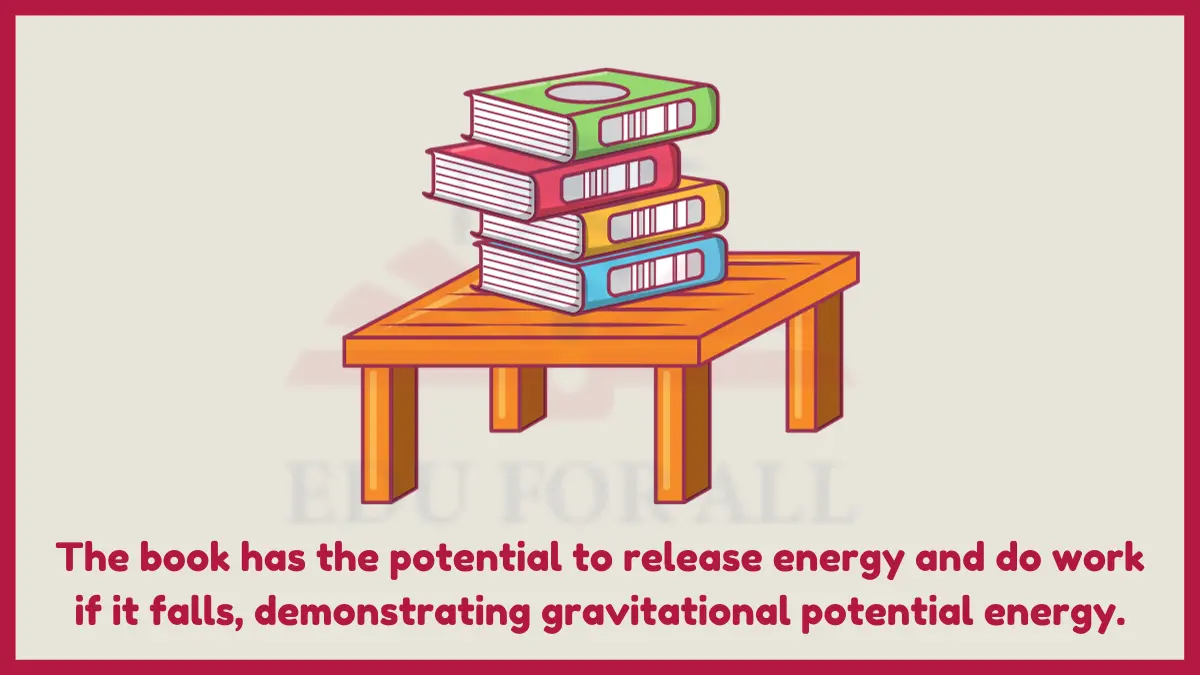Imagine a book perched on a high shelf. That book holds potential energy, ready to be unleashed if it falls. Now think of a compressed spring, coiled tightly like a snake. It too holds potential energy, waiting to be released when it snaps back to its original shape. And what about a charged battery? It’s packed with potential energy, ready to power your devices. These are just a few examples of potential energy, all around us, waiting to be transformed into kinetic energy.
Examples of Potential Energy
Here are 10 examples of potential energy:
1. Book on a Table
A book resting on a table has gravitational potential energy due to its position above the floor. The book has the potential to release energy and do work if it falls from the table to the floor. The higher the table, the greater the gravitational potential energy stored in the book.

Experiment: Place a book on a table at different heights. Measure the height of each position and the time it takes to fall to the ground. Observe how the time increases with increasing height, indicating the increase in gravitational potential energy.
2. Raised Hammer
A raised hammer has gravitational potential energy that can be transferred into kinetic energy when it falls. When held above the ground, it has the potential to accelerate with increasing velocity as it falls, converting potential energy into kinetic energy. The greater the height, the more potential energy.

Experiment: Hold a hammer at different heights above the ground and swing it down, measuring the distance it travels before hitting the ground. Repeat with different weights. Observe how the distance increases with both increasing height and weight, indicating the increase in gravitational potential energy.
3. Water Dam
Water held behind a dam has potential energy that can be converted into electricity by flowing water turbines. The water is able to do work as it falls from the dam height, turning the turbines. The higher the dam, the greater the stored potential energy.

Experiment: Build a small dam and fill it with water. Open a hole at the bottom and measure the distance the water sprays out. Repeat with different water levels behind the dam. Observe how the distance increases with increasing water level, indicating the increase in gravitational potential energy.
4. Charged Battery
The chemicals in a battery hold electrical potential energy that can provide power when discharged. Ions flow between the positive and negative terminals, releasing energy. The state of charge determines the amount of potential electrical energy stored.

Experiment: Connect a battery to a lightbulb and observe its brightness. Repeat with different types of batteries. Observe how the brightness varies with battery type, indicating the difference in potential energy storage.
5. Stretched Spring
A stretched or compressed spring contains stored elastic potential energy. As the spring is compressed or stretched from its resting position, it gains the potential to snap back and do work like turning gears in a clock. Greater displacement increases potential energy.

Experiment: Attach a spring to a weight and measure its resting length. Stretch the spring, release it, and measure the distance it travels before coming to rest. Observe how the distance increases with the amount of stretch, indicating the increase in elastic potential energy.
6. Bow and Arrow
The drawn bowstring of an archery bow stores elastic potential energy that propels the arrow. Stretching the bowstring requires work and stores energy based on the distance pulled. This can be transferred into the kinetic energy of the arrow in flight.

Experiment: Draw back the bowstring of an archery bow and measure the distance pulled. Fire the arrow and measure the distance it travels. Repeat with different bowstring pulls. Observe how the arrow’s distance increases with the bowstring pull, indicating the transfer of elastic potential energy to kinetic energy.
7. Pendulum at Top of Swing
A pendulum bob at the top of its arc has gravitational potential energy. At the top, all of the bob’s energy is in the form of potential energy, which will be converted to kinetic energy as it swings downward and gains speed.

Experiment: Construct a pendulum and pull it back to the top of its swing. Measure the height at different points in its swing. Observe how the height decreases as it swings down, indicating the conversion of gravitational potential energy to kinetic energy.
8. Raised Object
Any object lifted upwards gains gravitational potential energy relative to the ground. Lifting an object against gravity requires work and stores energy as a function of height. This stored energy can be released if the object falls or is dropped.

Experiment: Lift an object to different heights above the ground and measure the height of each position. Drop the object from each height and measure the time it takes to fall to the ground. Observe how the time increases with increasing height, indicating the increase in gravitational potential energy.
9. Trampoline
A trampoline stores potential energy when someone jumps on it, compressing the springs. As the jumper bounces up, the springs release this energy, propelling them back into the air. This cycle continues until the jumper’s energy is dissipated.

Experiment: Wind a watch spring tightly and attach it to a toy car. Release the watch spring and observe how far the toy car travels. Repeat with different tightness levels. Observe how the distance increases with the tightness of the spring, indicating the increase in stored elastic potential energy.
10. Water Tower
Water in an elevated tower has gravitational potential energy that can provide pressure. The higher the water level, the more potential energy can push water through pipes due to gravity. Height creates pressure from stored energy.

Experiment: Construct a miniature water tower using transparent materials like plastic bottles or tubes. Fill the water tower with water to different levels. Attach a hose or tube to the bottom of the water tower and open the valve. Measure the distance the water sprays out at each water level.

